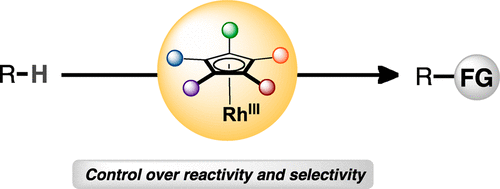当前位置:
X-MOL 学术
›
Acc. Chem. Res.
›
论文详情
Our official English website, www.x-mol.net, welcomes your feedback! (Note: you will need to create a separate account there.)
Electronic and Steric Tuning of a Prototypical Piano Stool Complex: Rh(III) Catalysis for C–H Functionalization
Accounts of Chemical Research ( IF 18.3 ) Pub Date : 2017-12-22 00:00:00 , DOI: 10.1021/acs.accounts.7b00444 Tiffany Piou 1 , Tomislav Rovis 1
Accounts of Chemical Research ( IF 18.3 ) Pub Date : 2017-12-22 00:00:00 , DOI: 10.1021/acs.accounts.7b00444 Tiffany Piou 1 , Tomislav Rovis 1
Affiliation

|
The history of transition metal catalysis is heavily steeped in ligand design, clearly demonstrating the importance of this approach. The intimate relationship between metal and ligand can profoundly affect the outcome of a reaction, often impacting selectivity, physical properties, and the lifetime of a catalyst. Importantly, this metal–ligand relationship can provide near limitless opportunities for reaction discovery. Over the past several years, transition-metal-catalyzed C–H bond functionalization reactions have been established as a critical foundation in organic chemistry that provides new bond forming strategies. Among the d-block elements, palladium is arguably one of the most popular metals to accomplish such transformations. One possible explanation for this achievement could be the broad set of phosphine and amine based ligands available in the chemist’s toolbox compatible with palladium. In parallel, other metals have been investigated for C–H bond functionalization. Among them, pentamethylcyclopentadienyl (Cp*) Rh(III) complexes have emerged as a powerful mode of catalysis for such transformations providing a broad spectrum of reactivity. This approach possesses the advantage of often very low catalyst loading, and reactions are typically performed under mild conditions allowing broad functional group tolerance. Cp*Rh(III) is considered as a privileged catalyst and a plethora of reactions involving a C–H bond cleavage event have been developed. The search for alternative cyclopentadienyl based ligands has been eclipsed by the tremendous effort devoted to exploring the considerable scope of reactions catalyzed by Cp*Rh(III) complexes, despite the potential of this strategy for enabling reactivity. Thus, ligand modification efforts in Rh(III) catalysis have been an exception and research directed toward new rhodium catalysts has been sparse. Recently, chiral cyclopentadienyl ligands have appeared allowing enantioselective Rh(III)-catalyzed C–H functionalization reactions to be performed. Alongside chiral ligands, an equally important collection of achiral cyclopentadienyl-derived ligands have also emerged. The design of this new set of ligands for rhodium has already translated to significant success in solving inherent problems of reactivity and selectivity encountered throughout the development of new Rh(III)-catalyzed transformations. This Account describes the evolution of cyclopentadienyl ligand skeletons in Rh(III)-catalysis since the introduction of pentamethylcyclopentadienyl ligands to the present. Specific emphasis is placed on reactivity and synthetic applications achieved with the new ligands with the introduction of achiral mono-, di-, or pentasubstituted cyclopentadienyl ligands exhibiting a stunning effect on reactivity and selectivity. Furthermore, an underlying question when dealing with ligand modification strategies is to explain the reason one ligand outperforms another. Conjecture and speculation abound, but extensive characterization of their steric and electronic properties has been carried out and information about electronic and steric properties of the ligands all contribute to our understanding and give crucial pieces to solve the puzzle.
中文翻译:

原型钢琴凳复合体的电子和立体声调音:Rh(III)催化C–H功能化
过渡金属催化的历史在配体设计中非常繁琐,清楚地证明了这种方法的重要性。金属和配体之间的密切关系会深刻影响反应的结果,通常会影响选择性,物理性质和催化剂的寿命。重要的是,这种金属-配体关系可以为反应发现提供几乎无限的机会。在过去的几年中,过渡金属催化的C–H键官能化反应已被确立为有机化学中提供新的键形成策略的重要基础。在d嵌段元素中,钯可以说是完成此类转变的最受欢迎的金属之一。这一成就的一个可能的解释可能是化学家工具箱中与钯兼容的广泛的膦和胺基配体。同时,还对其他金属进行了C–H键官能化的研究。其中,五甲基环戊二烯基(Cp *)Rh(III)配合物已成为这种转化的强大催化方式,可提供广泛的反应活性。该方法具有通常非常低的催化剂载量的优点,并且反应通常在温和的条件下进行,从而允许宽泛的官能团耐受性。Cp * Rh(III)被认为是一种特权催化剂,并且已经开发了涉及CH键断裂事件的大量反应。尽力探索由Cp * Rh(III)配合物催化的相当大的反应范围,尽管这种策略具有实现反应性的潜力,但人们对寻找替代的基于环戊二烯基的配体的努力已经黯然失色。因此,Rh(III)催化中配体修饰的努力是一个例外,针对新型铑催化剂的研究也很少。最近,手性的环戊二烯基配体已经出现,可以进行对映体选择性的Rh(III)催化的C–H功能化反应。除手性配体外,还出现了同样重要的非手性环戊二烯基衍生的配体集合。这套新的铑配体的设计已成功解决了在开发新型Rh(III)催化的转化过程中遇到的固有的反应性和选择性问题,取得了巨大的成功。该描述描述了自引入五甲基环戊二烯基配体以来Rh(III)催化中环戊二烯基配体骨架的演变。通过引入对反应性和选择性表现出惊人影响的非手性单,二或五取代的环戊二烯基配体,特别强调了通过新配体实现的反应性和合成应用。此外,处理配体修饰策略时的一个基本问题是解释一种配体优于另一种配体的原因。猜想和猜想比比皆是,
更新日期:2017-12-22
中文翻译:

原型钢琴凳复合体的电子和立体声调音:Rh(III)催化C–H功能化
过渡金属催化的历史在配体设计中非常繁琐,清楚地证明了这种方法的重要性。金属和配体之间的密切关系会深刻影响反应的结果,通常会影响选择性,物理性质和催化剂的寿命。重要的是,这种金属-配体关系可以为反应发现提供几乎无限的机会。在过去的几年中,过渡金属催化的C–H键官能化反应已被确立为有机化学中提供新的键形成策略的重要基础。在d嵌段元素中,钯可以说是完成此类转变的最受欢迎的金属之一。这一成就的一个可能的解释可能是化学家工具箱中与钯兼容的广泛的膦和胺基配体。同时,还对其他金属进行了C–H键官能化的研究。其中,五甲基环戊二烯基(Cp *)Rh(III)配合物已成为这种转化的强大催化方式,可提供广泛的反应活性。该方法具有通常非常低的催化剂载量的优点,并且反应通常在温和的条件下进行,从而允许宽泛的官能团耐受性。Cp * Rh(III)被认为是一种特权催化剂,并且已经开发了涉及CH键断裂事件的大量反应。尽力探索由Cp * Rh(III)配合物催化的相当大的反应范围,尽管这种策略具有实现反应性的潜力,但人们对寻找替代的基于环戊二烯基的配体的努力已经黯然失色。因此,Rh(III)催化中配体修饰的努力是一个例外,针对新型铑催化剂的研究也很少。最近,手性的环戊二烯基配体已经出现,可以进行对映体选择性的Rh(III)催化的C–H功能化反应。除手性配体外,还出现了同样重要的非手性环戊二烯基衍生的配体集合。这套新的铑配体的设计已成功解决了在开发新型Rh(III)催化的转化过程中遇到的固有的反应性和选择性问题,取得了巨大的成功。该描述描述了自引入五甲基环戊二烯基配体以来Rh(III)催化中环戊二烯基配体骨架的演变。通过引入对反应性和选择性表现出惊人影响的非手性单,二或五取代的环戊二烯基配体,特别强调了通过新配体实现的反应性和合成应用。此外,处理配体修饰策略时的一个基本问题是解释一种配体优于另一种配体的原因。猜想和猜想比比皆是,



























 京公网安备 11010802027423号
京公网安备 11010802027423号